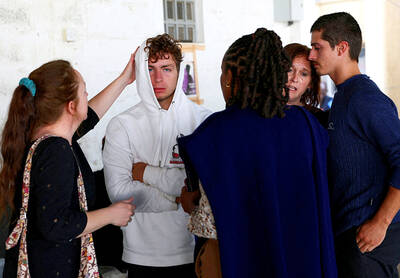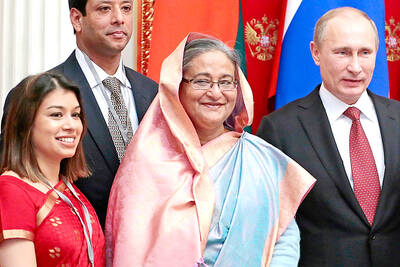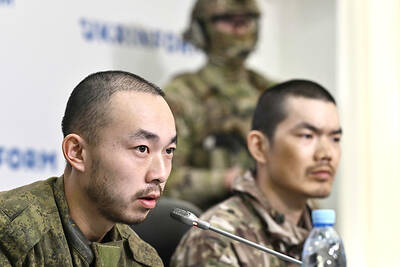Ronberto Garcia picks up a freshly-made, well-oiled automatic sub-machine gun from a formica table under a huge gazebo and screws on a long silencer.
"We sell these guns to anyone, provided they have money," Garcia says, proudly showing the weapon to a group gathered in his heavily secured concrete home.
The gun is his top-selling product and helps him make a killing, financially, in a nation where weapons sales are big business.
Garcia is the leading arms broker in Danao, a sprawling town of 100,000 people in the central Philippine province of Cebu and the center of the lucrative arms trade.
It is here in workshops tucked away in tiny back streets of Danao that self-taught gunsmiths churn out faithful replicas of arms from Israeli Uzis to 45-caliber handguns and KG-9 assault rifles used by American Navy Seals.
The illegal trade has become so large that it has surpassed the more traditional and legal methods of earning a living such as farming and fishing, according to townsfolk.
Many of the gunsmiths are former coconut farmers who have found that making guns is a more lucrative way of making a living than hanging from a tree harvesting coconuts for a few hundred pesos a day.
While there are no official statistics, thousands of people probably rely on gunmaking for money to send their children to school and to build modest cinder-block homes in Danao.
According to the Philippine National Police there are some 900,000 registered firearms in the Philippines and possibly as many as 450,000 unregistered. And that does not include the 150,000 firearms estimated to be in the hands of criminal gangs, warlords, communist and Muslim insurgents.
The local gunsmiths use thick sheets of metal salvaged or bought from ship-breaking yards in Cebu City, the bustling main port city some 35km to the south.
They used to churn out dozens of six and eight-shot revolvers called "paltiks," but as Garcia says "times have changed, and people want more powerful firearms."
Garcia is actually a fictitious name used by Danao's leading arms dealer whose family is among the pioneers of the illegal trade that dates back to the early 1970s.
"We are just plain businessmen who sell something people want," the portly 53-year-old Garcia said in his home, which is hidden from the main road and accessible only by a dirt road. You enter the heavy metal gates after passing several houses and a latrine guarded by dogs.
The copy KG-9 in Garcia's range looks exactly like the original, down to the insignia on its barrel that says: "Scorpion. Navy Seals Logistics. US government property."
Well-crafted high caliber guns are sold for up to 20,000 pesos while handguns fetch as much as 4,000 pesos a piece -- far better than the several hundred pesos typically earned by farmers on a good day of toiling in the fields.
While gunmaking is illegal, authorities have for decades turned a blind eye because it provides an alternative livelihood for the people than relying on subsistence farming and fishing.
"The sound of gunshots echoing in the air are welcomed by the townsfolk because it means money," Garcia says.
"The only time you see a lot of people in the market is when gun sales here are up. People cannot just rely on fishing and farming all the time," Garcia says. "Here, people are happy when they hear gunshots."
Sales are mostly up during election season when rival politicians beef up their private armies or security forces and during Christmas, when people have extra money to spend for guns as gifts, he said.
Guns made in Danao have become so famous that Japanese Yakuzas were known in the past to fly to the central Philippines to collect them, townsfolk say. Military officials as well as local politicians also buy them for their own purposes.
"Everyone buys from us. The military officials, some foreigners too, and civilians for their protection," Garcia says, but stops short when asked if he has ever sold firearms to communist guerrillas who proliferate in the countryside.
Danao guns are bought on a cash basis, and deals are done without any papers changing hands. Word of honor is important between buyer and seller and anyone seeking to buy is screened thoroughly.
Tension is high around Garcia's compound, and his men are on alert because recently a special police task force swooped down on his neighbor's home and confiscated 160 pieces of "bakal," the local slang for guns.
There are no actual figures as to how many guns are produced in Danao at any given time, but Garcia estimates up to 500 units of various gun models are smuggled out of the area every month.

Incumbent Ecuadoran President Daniel Noboa on Sunday claimed a runaway victory in the nation’s presidential election, after voters endorsed the young leader’s “iron fist” approach to rampant cartel violence. With more than 90 percent of the votes counted, the National Election Council said Noboa had an unassailable 12-point lead over his leftist rival Luisa Gonzalez. Official results showed Noboa with 56 percent of the vote, against Gonzalez’s 44 percent — a far bigger winning margin than expected after a virtual tie in the first round. Speaking to jubilant supporters in his hometown of Olon, the 37-year-old president claimed a “historic victory.” “A huge hug

Two Belgian teenagers on Tuesday were charged with wildlife piracy after they were found with thousands of ants packed in test tubes in what Kenyan authorities said was part of a trend in trafficking smaller and lesser-known species. Lornoy David and Seppe Lodewijckx, two 19-year-olds who were arrested on April 5 with 5,000 ants at a guest house, appeared distraught during their appearance before a magistrate in Nairobi and were comforted in the courtroom by relatives. They told the magistrate that they were collecting the ants for fun and did not know that it was illegal. In a separate criminal case, Kenyan Dennis

A judge in Bangladesh issued an arrest warrant for the British member of parliament and former British economic secretary to the treasury Tulip Siddiq, who is a niece of former Bangladeshi prime minister Sheikh Hasina, who was ousted in August last year in a mass uprising that ended her 15-year rule. The Bangladeshi Anti-Corruption Commission has been investigating allegations against Siddiq that she and her family members, including Hasina, illegally received land in a state-owned township project near Dhaka, the capital. Senior Special Judge of Dhaka Metropolitan Zakir Hossain passed the order on Sunday, after considering charges in three separate cases filed

APPORTIONING BLAME: The US president said that there were ‘millions of people dead because of three people’ — Vladimir Putin, Joe Biden and Volodymyr Zelenskiy US President Donald Trump on Monday resumed his attempts to blame Ukrainian President Volodymyr Zelenskiy for Russia’s invasion, falsely accusing him of responsibility for “millions” of deaths. Trump — who had a blazing public row in the Oval Office with Zelenskiy six weeks ago — said the Ukranian shared the blame with Russian President Vladimir Putin, who ordered the February 2022 invasion, and then-US president Joe Biden. Trump told reporters that there were “millions of people dead because of three people.” “Let’s say Putin No. 1, but let’s say Biden, who had no idea what the hell he was doing, No. 2, and